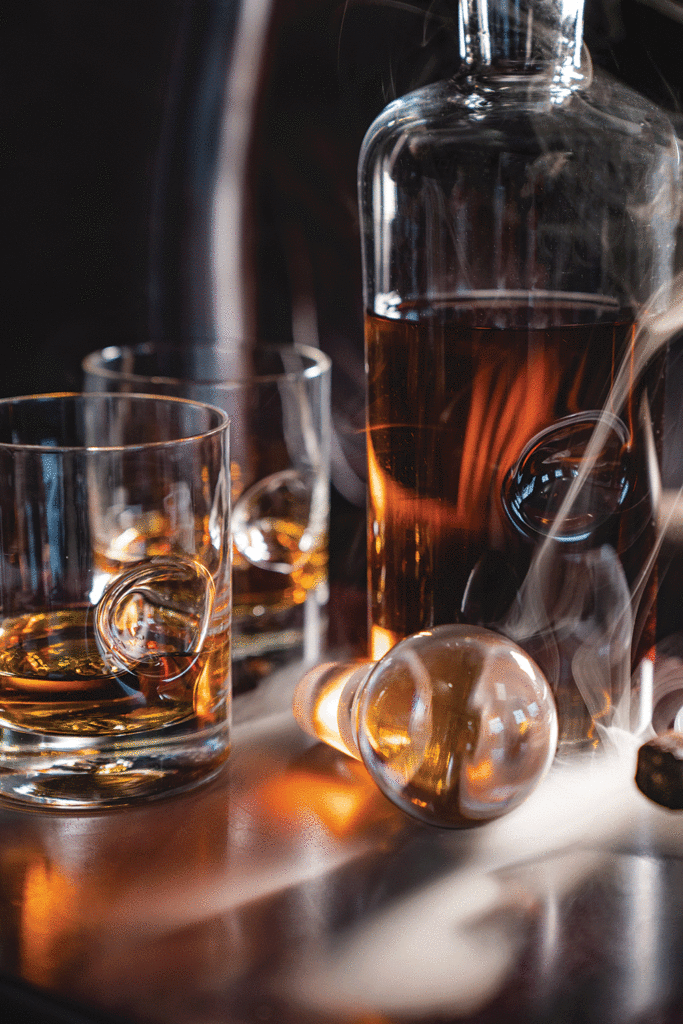Biology of Bourbon

You may have heard someone describing his or her bourbon as having distinctive flavors, such as specific fruit, floral, spice, or herbal aromatics. But when a bourbon is said to be “appley,” that doesn’t mean that apple juice has been added to it. That would be against the law. According to the Federal Standards of Identity, the only substance that can be added to bourbon whiskey is distilled water in order to adjust the proof—no coloring or flavoring allowed.
Of course, there are flavored whiskeys. Think Jim Beam Kentucky Fire with cinnamon added. (Or don’t!) And because of that additive, the word “bourbon” will appear nowhere on the label. Nonetheless, many bourbons will have a detectable note of cinnamon—or apple or hazelnuts. In fact, more than 200 distinctive flavors have been recorded in bourbon by the professional tasting panels at distilleries and can be more or less categorized as caramel/vanilla, bread/yeast, fruits, spices, sugar/sweet, floral, herbal, nutty, and earthy. How do they get there?
The answer lies in the biology and chemistry of bourbon making. Every step in the process is significant, but the main contributors can be narrowed to three major factors: grains, yeast, and aging.
Mash Bill The recipe of grains cooked and then fermented is the mash bill. Bourbon has to be at least 51 percent corn, but in practice is a few points either side of 70 percent. This, in large part, accounts for bourbon being sweeter than rye whiskey or Scotch. Think about the difference between cornbread and rye bread. Scotch is made with malted barley, which has a nutty character. When wheat is used in place of rye (which lends some peppery notes) in certain bourbons, that generally results in some smoothness. Again, consider wheat bread compared to other types. These grains will be especially apparent in young bourbons aged less than three years—look for cornbread, cornmeal, malt, herbal rye, and yeasty dough notes. Malted barley (usually 5 to 12 percent of the mash bill) contributes that aforementioned nuttiness.
Yeast Strain Everyone appreciates the role yeast has in the all-important process of fermentation. But there’s a reason that distilleries are very particular about which strain of yeast they use. The larger ones have high-tech laboratories that maintain their yeast cultures and monitor them for any genetic changes. That’s because one of the by-products of fermentation, besides alcohol and carbon dioxide, is a raft of aromatic compounds called esters. These can be fruity (apple, pear, banana, orange, lemon, mango, or cherry) or floral (orange blossom, rose, honeysuckle, lavender, or peach blossom). Herbal notes like mint may come from a yeast strain, too. Different yeast strains produce different complex ester compounds. Change the yeast and you change the whiskey.
Aging This may be the most important flavor factor of all. Aging in the new charred-oak barrel imparts 100 percent of the color to bourbon. Further, the movement of the bourbon in and out of the layers of the toasted and charred wood accounts for 70 percent or more of flavor. Toasting the wood caramelizes wood sugars, very similar to how torching the sugar on top of crème brûlée results in the caramelized crust. It also releases a compound called vanillin (yes, the vanilla flavor in bourbon), and some more esters, especially baking spices such as cinnamon, nutmeg, and allspice. The source of chocolate, nuts, and tobacco notes is imbued in this process, too.
There is a fine art to aging. How dark should the toast be? How many years should the bourbon be in the warehouse? On what floor? Near the top where more evaporation of water happens because of the high temperature, which increases the proof? Or on lower, cooler levels where more alcohol evaporates, but aging can take place longer, so the whiskey doesn’t turn woody and bitter? Aging is a fine balancing act.
Other steps in the bourbon-making process, including distillation, filtration (or not), and proof upon bottling contribute to flavor complexity, too. In short, permutations of the factors are almost endless. That’s how there can be hundreds of bourbon brands on the market today, with more in the offing.
























